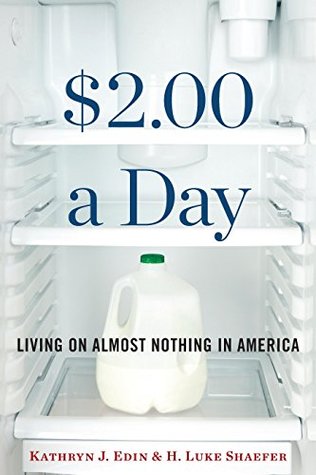More on this book
Community
Kindle Notes & Highlights
Read between
August 2 - August 9, 2022
In early 2011, 1.5 million households with roughly 3 million children were surviving on cash incomes of no more than $2 per person, per day in any given month.
While single-mother families were most at risk of falling into a spell of extreme destitution, more than a third of the households in $2-a-day poverty were headed by a married couple. And although the rate of growth was highest among African Americans and Hispanics, nearly half of the $2-a-day poor were white.
The government’s emphasis on personal responsibility must be matched by bold action to expand access to, and improve the quality of, jobs. But there will always be circumstances in which work as a primary approach to alleviating poverty won’t work.
There are more avid postage stamp collectors in the United States than welfare recipients.
Service sector employers often engage in practices that middle-class professionals would never accept. They adopt policies that, purposely or not, ensure regular turnover among their low-wage workers, thus cutting the costs that come with a more stable workforce, including guaranteed hours, benefits, raises, promotions, and the like. Whatever can be said about the characteristics of the people who work low-wage jobs, it is also true that the jobs themselves too often set workers up for failure.
Recent research has found that when a new Walmart opens in a community, it causes an overall loss in jobs in that community because other stores—including some that might pay better or offer stable hours—can’t compete.
Today there is no state in the Union in which a family that is supported by a full-time, minimum-wage worker can afford a two-bedroom apartment at fair market rent without being cost burdened, according to HUD.
According to some estimates, roughly 60 percent of abusers are familiar to the child but are not family members, while 30 percent of abusers, like José, are related to the child. Strangers make up only 10 percent of perpetrators. Abusers are also likely to misuse alcohol or drugs. Children who have multiple caretakers are most at risk, as are children who are emotionally vulnerable
Rae likely suffers from the effects of what researchers refer to as “toxic stress,” defined as “strong, frequent, or prolonged activation of the body’s stress response systems in the absence of the buffering protection of a supportive, adult relationship.”
Our approach to ending $2-a-day poverty is guided by three principles: (1) all deserve the opportunity to work; (2) parents should be able to raise their children in a place of their own; and (3) not every parent will be able to work, or work all of the time, but parents’ well-being, and the well-being of their children, should nonetheless be ensured.


